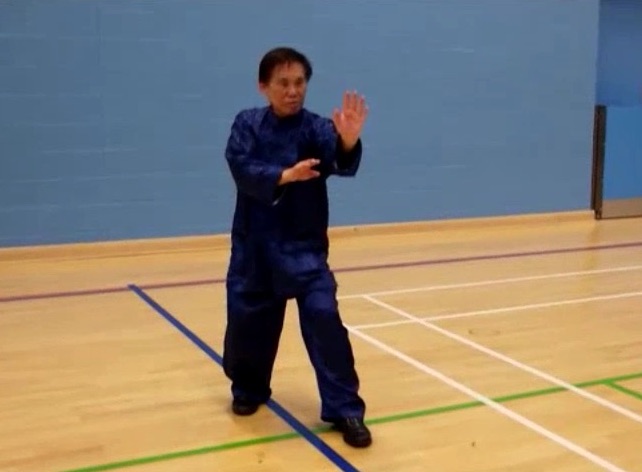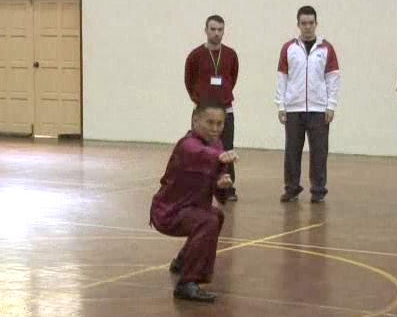THE THREE-BODY STANCE AND "HEI SAI" OR SPIRIT OF ENERGY

Santi-Shi or Three-Body Stance of Xingyiquan
Question
If I remember correctly you somewhere mentioned the focus mode and the cosmos mode. Can Sigung explain to us what these modes are, if these are attainments of standing meditation and which benefits does standing meditation have on people who are ill physically and / or psychologically.
I think there are a few people in the west who think that meditation is a simple, direct and effective way to heal body and soul. Can Sigung please share with us his view about that with special emphasis on standing meditation?
How do Chi Flow and the hei sai spirits influence Standing Meditation?
Bernhard
Answer
You did not remember correctly.
It was not the focus mode and the cosmos mode, but the correspondence mode and the expansion mode. It did not refer to the Wuji Stance or standing meditation; it referred to the Three-Body Stance.
I mentioned the correspondence mode and the expansion mode when performing the Three-Body Stance at a regional Xingyiquan course of the UK Summer Camp in July 2013.
The Three-Body Stance is called “Santi-Shi” in Romanized Chinese. It refers to three aspects of the body, namely the hands, the legs and the trunk. The Three-Body Stance is also called the Triangle Stance, and is similar to the Four-Six Stance and the Stream-Character Stance.
The Three-Body Stance is a fundamental stance to develop internal force in Xingyiquan. At first I wondered why the Three-Body Stance was used as it is not symmetrical, unlike the Horse-Riding Stance in Shaolin Kungfu or the Three-Circle Stance in Taijiquan.
When I read a Xingyiquan classic, I found the answer. The classic mentioned the correspondence mode and the expansion mode. In the correspondence mode, practitioners focus their chi at the corresponding hand and foot. If a practitioner is in the left Three-Body Stance, i.e. the left hand and the left foot in front, the focus is on the left hand and the right foot. If the practitioner is in the right Three-Body Stance, i.e. the right hand and the right foot in front, the focus is on the right hand and the left foot. In the expansion mode, practitioners expand their chi. These two modes overcome the asymmetrical structure of the Three-Body Stance.
The correspondence mode is not used in the Wuji Stance or standing meditation, but the expansion mode is used in the Wuji Stance. But the use of the expansion mode in the Wuji Stance is different from that in the Three-Body Stance. If the expansion mode in the Wuji Stance is used in the same way as in the Three-Body Stance, or vice versa, the two modes may be detrimental to the two stances.
The correspondence mode and the expansion mode in the Three-Body Stance as well as the expansion mode in the Wuji Stance are detrimental to people who are physically or psychologically ill. Ill people should practice exercises from the 18 Jewels, Five-Animal Play or self-manifested chi movement. These modes are too powerful. This is an important point many people may not realize.
Meditation, which is spiritual cultivation, is not suitable to heal the body and soul. Practitioners should practice meditation only when they are ready. They should at least be healthy. That was the reason why the great Bodhidharma taught the Eighteen Lohan Hands. He found the monks sick and weak. Eighteen Lohan Hands could strength them.
Most people do not practice any form of meditation, including standing meditation, correctly. They just stand upright, or think they are upright though they usually lean back. They are tensed and stressful.
The term “hei sai” in Cantonese was invented by me. Literally it means “energy-form”. “Hei sai” was very noticeable in all my sifus. When they performed kungfu, they demonstrated “hei sai”, which was an invisible but perceptible flow of energy or spirit that was pressing.
Standing meditation focuses on training of mind or spirit. If chi flow occurs, depending on how vigorously the outward movements are, it changes to self-manifested chi movement, flowing water floating clouds, flowing breeze swaying willows, or flowingly still. Relatively, self-manifested chi movement is good for overcoming illness, flowing water floating clouds and flowing breeze swaying willows good for peak performance, and flowingly still good for spiritual cultivation.
When performing standing meditation, a practitioner’s “hei-sai” should not be pressing like when he performs kungfu movements, but should be peaceful and cheerful, which are the objectives of spiritual cultivation.

The "hei-sai" or spirit of energy of Grandmaster Wong while performing Wudang Taijiquan
The questions and answers are reproduced from the thread Questions on Wuji Stance or Standing Meditation in the Shaolin Wahnam Discussion Forum.
LINKS
